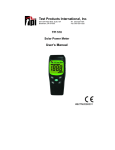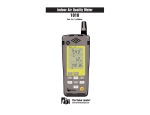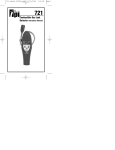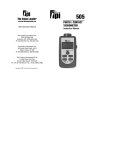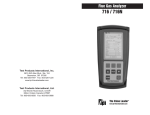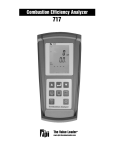Download TPI 85 User Manual © Version 1 (November 2005)
Transcript
Test Products International Inc. Headquarters 9615 SW Allen Blvd Beaverton OR 97005 USA 503-520-9197 · Fax 503-520-1225 email: [email protected] Test Products International Ltd. 342 Bronte St. South Unit #9 Milton, Ontario L9T 5B7 Canada 905-693-8558 · Fax 905-693-0888 email: [email protected] Test Products International (Europe) Ltd Longley House International Drive Southgate Crawley West Sussex RH10 6AQ Tel: +44 (0) 1293 530196 Fax: +44 (0) 1293 531870 e-mail: [email protected] This symbol indicates that at the end of its life this product must not be disposed of in household waste. This equipment should be environmentally disposed of. Please contact your supplier or manufacturer who will be able to advise you on the correct method of disposal. TPI 85 User Manual © Version 1 (November 2005) EC Declaration of Conformity In accordance with BS EN ISO/IEC 17050-1 We, Test Products International Europe Ltd. Of Longley House, International drive, Crawley, West Sussex RH10 6AQ declare that: Equipment: Multi-Functional Earth – Loop Tester Model Number: TPI 85 in accordance with the following Directives: 73/23/EEC The Low Voltage Directorate 89/336/EEC The Electromagnetic Compatibility Directive Has been designed and manufactured to the following standards: Appendix C: Guarantee Your TPI 85 Multi Functional Earth Loop Tester is guaranteed free from defects in materials and workmanship for 3 Years. Covered by TPI: Repair parts and labour; or replacement of the product at the option of TPI. Normal transportation charges to the purchaser are also covered. Not covered by TPI: Damage to the product which is the result of abuse, improper use or maintenance is not covered. Any other expenses, consequential damages, incidental expenses including damages to property are not covered. Transportation expenses to the customer are not covered. BS EN 61326 Electrical equipment for measurement, control and laboratory use. EMC requirements. BS EN 61010-1 Safety requirements for electrical equipment for measurement, control and laboratory use. General requirements. To obtain warranty performance: - Include with the product your name, address, phone number, written description of the problem and proof of purchase date. Carefully package and return to TPI. BS EN 61010-031 Safety requirements for electrical equipment for measurement, control and laboratory use. Safety requirements for hand held probe assemblies for electrical measurement and test. Warning: There are no user serviceable or replaceable parts within the instrument. Removal of the cabinet cover will invalidate the warranty. I hereby declare that the equipment named above has been designed to comply with the relevant sections of the above referenced standards. The unit complies with all the essential requirements of the Directives. This guarantee does not affect your statuary rights. Signed by E. Quigley, Managing Director. Test Products International Europe Ltd., at TPI Europe on 15th November 2005. 13 Appendix B Specification Contents Wiring Test Detects missing E or N Detects L-E or L-N swap Polarity Test Detects Live – Earth phase reversal by use of touchpad Fault indicated by chart on front of instrument Line Voltage Measurement Range LED < 207V AC 207 – 253V AC > 263V AC Low (Red) Standard (Green) High (Red) Loop Test Result displayed on 6 LED’s Test Current <15mA at 253V AC Range LED Accuracy <1W < 10 W < 100W < 200 W > 200 Green Orange Orange Orange Red 10% ±0.3W Standards CE Marked BS EN 61010-1 300V CAT III BS EN 61010-031 BS EN 61326 EMC Important: This instrument is designed to operate safely on domestic low voltage alternating current (AC) systems only, which normally operate at around 230 V AC. It should not normally be subjected to voltages above 300 V AC nor used on Direct Current (DC) circuits. 1. Introduction 2. Why Measure Earth-Loop Impedance 3. Instrument Overview 3.1 Front View 3.2 Top View 3.3 Test Lead 4. Using the Multi – Function Earth Loop Tester 4.1 Correct Wiring Indicator 4.2 Voltage Indicator 4.3 Earth - Loop Test 4.4 Polarity Test Appendix A: Fault Conditions Indication Chart Appendix B: Specification Appendix C: Guarantee 1. Introduction Thank you for purchasing TPI brand products. The TPI 85 MultiFunction Earth Loop Tester is a state of the art, easy to use instrument that is designed to test the safety of an electrical appliance/installation. It can be used prior to or following any adjustment, replacement of components, or fault finding operations. The instrument can be used to indicate in the order shown: § § § § the correct or incorrect wiring of an electrical circuit indicate the correct or incorrect voltage of the circuit indicate the Earth - Loop Impedance of the circuit indicate correct or incorrect polarity The instrument is ruggedly constructed and comes with a 3 Year Limited Guarantee (See Appendix C). 12 1 This manual will guide you through the functions of the TPI 85 which will give you many years of reliable service. Your TPI 85 Multi-Function Earth Loop Tester comes complete with: l l l l One Test lead incorporating a UK style 3 pin plug (fitted with a 13 Amp fuse) at one end and a IEC type connector fitted at the other end, which interfaces with the instrument for testing via Socket Outlets A second test lead which is equipped with 3 separate probes to enable testing via connections other than where a Socket Outlet is present Instruction Manual Carry Case 2. Why Measure Earth Loop Impedance? Whereas a digital multi-meter can be used to prove correct wiring, voltage and polarity, the checking of Earth-Loop Impedance can only be achieved using an instrument specifically designed for this purpose. The term ‘Impedance’ is defined as “the delay, or the preventing of progress of something”. In the case of electricity, it is better defined as “the opposition in a circuit to the flow of alternating current, consisting of resistance and reactance”. The TPI Multi-Function Tester is designed to indicate ‘Earth Loop Impedance’, which can best be explained as a function that can measure the resistance and reactance to the flow of an alternating current in an electrical circuit. Whereas measuring ‘Resistance to Earth’, using a digital multimeter will show that there is a good connection with low resistance, between the two points being measured; it does not prove how efficient the path to earth will be under fault conditions. 2 5. Calibration & Servicing. It is recommended that the unit is checked and calibrated as annually. If required, TPI provide a service for the checking and recalibration of instruments. Please consult Test Products International for further details. Appendix A: Fault Conditions Indication Chart The chart below details the correct and fault conditions as indicated by the various combinations of LED’s as shown by the ‘Correct Wiring Indicator’ display Display Tone ● Continuous (3 seconds) ●● Intermittent Intermittent Intermittent Intermittent Intermittent Condition Indicated Correct L & E reversed, or L, N, E Incorrectly connected L & N reversed, or L, N, E Incorrectly connected Neutral Fault, or L & E Incorrectly connected Earth Fault, or L & N reversed Live Fault, or N & E Incorrectly Connected No mains present (confirm against known power source) Ο None ΟΟ Key: ● Continuous display of LED to indicate correct condition = Flashing display of LED to indicate fault condition Ο = Blank display to indicate no power to LED = green flashing LED. = Orange flashing LED. =Red flashing LED 11 4.4 Polarity Test. Upon completion of the Earth-Loop Impedance Test, a Polarity Test should be conducted so as to confirm that the supply system is correctly connected. Place a finger firmly on the ‘Touch Pad’ (See Figure 6) and maintain pressure for a few seconds. The 3 LED’s of the ‘Correct Wiring Indicator’ will remain green to indicate correct polarity. Incorrect Polarity is indicated by the 3 LED’s intermittently flashing Red. Checking the Earth-Loop Impedance will measure the resistance of the earth path used by a current flow during a fault condition. It will ensure that during any fault condition, the flow of electricity to earth will be sufficient to cause the circuit protective device e.g. fuse or circuit breaker, to rapidly halt the flow of electricity through that circuit. 2. Instrument Overview Wiring Indicator Reference chart Correct Wiring Indicator Voltage Indicator Figure 6. Any failures should be investigated. This will normally be the responsibility of the electricity supply company who should be advised accordingly. Earth - Loop Indicator Polarity Test Pad Earth-Loop Test Button Figure 1. 10 3 3.1 Front View (see Figure 1) Correct Wiring Indicator – Indicates the correct wiring of the socket outlet under test by displaying three green Light emitting Diodes (LED’s) and a continuous tone for 3 seconds. Incorrect wiring is indicated by a series of orange or red flashing LED’s and an intermittent tone being emitted. Wiring Indictor Reference Chart – Helps identity the most common fault conditions and how they are displayed by the instrument. Voltage indicator – Indicates the range of the voltage using the ranges specified by British Standard BS7697:1993 (Nominal voltages for low voltage public electricity supply systems). Earth – Loop Indicator- On pressing the Earth – Loop Test Button, an indication of the range of the earth – loop impedance will be displayed. Polarity Test Pad – On completion of all other tests, firmly pressing the ‘Test Pad’ will confirm the polarity of the supply system. Earth – Loop Test Button – pressing this button starts the Earth – Loop test. WARNING: The TPI 85 Multi-Function Earth Loop Tester is a mains powered instrument and therefore does not incorporate an internal battery. There are no user serviceable parts inside the instrument and therefore the rear case of the instrument should not be removed. Acceptable Earth-Loop Impedance results depend on the type of circuit and the circuit protective device (fuse, Miniature Circuit Breaker [MCB] or Residual Current Device [RCD]) employed to protect the circuit under fault condition. Recommended Earth Loop Impedance results are detailed in British Standard 7671 (IEE Regulations) however, for guidance the indications displayed by this unit are discussed below: <1 W Any Earth Loop Impedance values of less than 1 Ohm can be considered acceptable and should be found in about 90% of most domestic electrical installations. <10 W This is still normally considered to be an acceptable reading, but it may indicate a loose earth connection and it may be worth checking the adequacy of the connection at the point of test. If the point of test is at the extreme of the electrical circuit, then earth – loop impedance readings can be expected to be higher. <100 W Such a reading should cause concern and should be investigated. However, if the electrical supply system is fed via overhead cables (known as a TT supply system) and an earth is provided via a spike driven into the ground, then the reading may normally be considered as acceptable. <200 W For any other supply system than a TT (as discussed above) this must be considered as a serious earth fault and should be investigated and corrected. Where a TT supply system is employed, providing the circuit is also protected by a Residual Current Device (RCD) rated at either 30mA or 100 mA then the reading may normally be considered as adequate. >200 W Any results exceeding 200 Ohms need to be investigated and resolved as a matter of urgency. NOTE: In the event of a concern about an electrical installation please consult a qualified electrician. 4 9 Note: This test is only performed after the instrument has first proved that the wiring is connected correctly (i.e. All correct wiring indicators are continuously green. While the voltage is being checked, the two outer red LED’s of the voltage indicator will be briefly illuminated. On completion of the check, the actual voltage range will be indicated by the appropriate LED as shown in Figure 4 below. The supply voltage can be considered correct if the centre green LED is lit, indicating a voltage between 207 & 253 V AC. Other voltage range indications should be investigated accordingly. 3.2 Top View Figure 2. The top of the instrument (see Figure 2) incorporates an IEC type connector that is used to connect the test leads (supplied) to the unit. 3.3 Test Leads. Figure 4. 4.3 Earth - Loop Test. After confirming correct voltage, press and release the Earth Loop Test Switch Button. The outer two (<1 W & >200 W) LED’s of the Earth Loop Indicator (See Figure 5) will illuminate briefly while the test is being undertaken. On completion of the test, the LED indicating the measured Earth-Loop Impedance will remain illuminated. Figure 3a Test Lead with 13 Amp Plug Figure 3b Test Lead with 3 separate probes Two test leads are supplied with the instrument (see Figure 3a & 3b). Both incorporate an IEC connector at one end, which connects to the socket on the top of the instrument. One test lead has a UK style 3 pin plug at the other end, which can be Figure 5. 8 5 used to perform testing via socket outlets of the electrical circuit to be tested. The other test lead incorporates 3 separate test probes at the other end of the lead, which enables testing from all other locations other than where a Socket Outlet is available e.g. at the point of connection to separate components such as pumps or fans etc. Before use, the instrument case, its test leads and probes should be checked for signs of damage or wear and if any damage is identified should not be used until repaired or replaced. The plug is fitted with a 13 Amp fuse and should be checked and replaced as necessary if the unit fails to operate while connected to a known powered circuit. continuously on a continuous tone will be emitted for 3 seconds. If there is a wrong connection or a wire not connected, the LED’s will be flashing and an intermittent bleep will be heard whilst the instrument remains connected to the power supply. Fault conditions, showing the colours of the flashing LED’s for most normal fault conditions are shown in the chart on the front of the instrument, immediately above the ‘Correct Wiring Indicator’ as shown in Figure 3. Full details of all fault conditions as shown in the Fault Conditions Indication Chart - Appendix 1 3. Using the Multi-function Earth - Loop Tester Warning. The TPI Multi-Function Tester is a mains powered instrument and does not rely on an internal battery. There are no user serviceable or replaceable parts within the instrument. Removal of the cabinet cover will invalidate the warranty. The Multi-Function tester automatically self checks and starts its series of tests as soon as it is connected to a ‘live’ power supply. The tests are conducted in the following order. 4.1 Correct Wiring Test Connect the instrument to the circuit to be tested and energise the circuit. The instrument will automatically ‘self test’ and check the Earth, Live and Neutral connections at the point of connection. During the tests a series of short bleeps will be heard and the Light Emitting Diodes (LED’s) will flash. Providing no problems are identified with the circuit under test, the three green LED’s of the correct wiring indicator will remain 6 Figure 3. 4.2 Voltage Indicator. After checking and confirming correct wiring, the instrument will automatically check the supply voltage. 7











